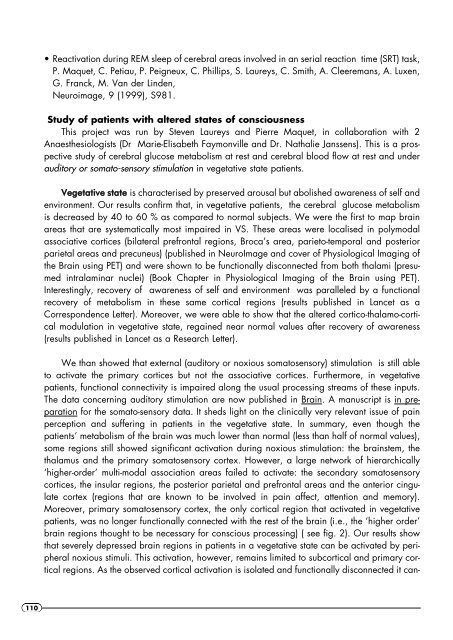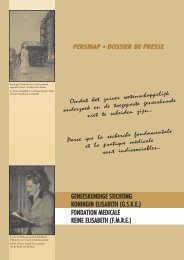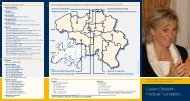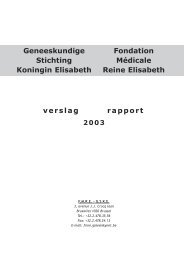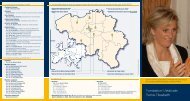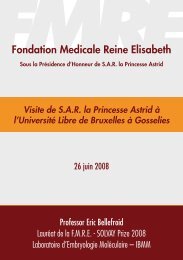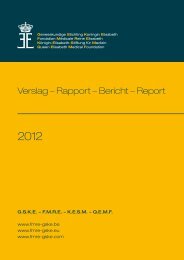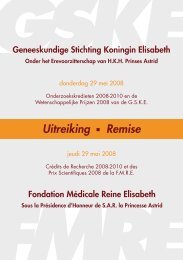Geneeskundige Stichting Koningin Elisabeth ... - GSKE - FMRE
Geneeskundige Stichting Koningin Elisabeth ... - GSKE - FMRE
Geneeskundige Stichting Koningin Elisabeth ... - GSKE - FMRE
You also want an ePaper? Increase the reach of your titles
YUMPU automatically turns print PDFs into web optimized ePapers that Google loves.
110<br />
• Reactivation during REM sleep of cerebral areas involved in an serial reaction time (SRT) task,<br />
P. Maquet, C. Petiau, P. Peigneux, C. Phillips, S. Laureys, C. Smith, A. Cleeremans, A. Luxen,<br />
G. Franck, M. Van der Linden,<br />
Neuroimage, 9 (1999), S981.<br />
Study of patients with altered states of consciousness<br />
This project was run by Steven Laureys and Pierre Maquet, in collaboration with 2<br />
Anaesthesiologists (Dr Marie-<strong>Elisabeth</strong> Faymonville and Dr. Nathalie Janssens). This is a prospective<br />
study of cerebral glucose metabolism at rest and cerebral blood flow at rest and under<br />
auditory or somato-sensory stimulation in vegetative state patients.<br />
Vegetative state is characterised by preserved arousal but abolished awareness of self and<br />
environment. Our results confirm that, in vegetative patients, the cerebral glucose metabolism<br />
is decreased by 40 to 60 % as compared to normal subjects. We were the first to map brain<br />
areas that are systematically most impaired in VS. These areas were localised in polymodal<br />
associative cortices (bilateral prefrontal regions, Broca’s area, parieto-temporal and posterior<br />
parietal areas and precuneus) (published in NeuroImage and cover of Physiological Imaging of<br />
the Brain using PET) and were shown to be functionally disconnected from both thalami (presumed<br />
intralaminar nuclei) (Book Chapter in Physiological Imaging of the Brain using PET).<br />
Interestingly, recovery of awareness of self and environment was paralleled by a functional<br />
recovery of metabolism in these same cortical regions (results published in Lancet as a<br />
Correspondence Letter). Moreover, we were able to show that the altered cortico-thalamo-cortical<br />
modulation in vegetative state, regained near normal values after recovery of awareness<br />
(results published in Lancet as a Research Letter).<br />
We than showed that external (auditory or noxious somatosensory) stimulation is still able<br />
to activate the primary cortices but not the associative cortices. Furthermore, in vegetative<br />
patients, functional connectivity is impaired along the usual processing streams of these inputs.<br />
The data concerning auditory stimulation are now published in Brain. A manuscript is in preparation<br />
for the somato-sensory data. It sheds light on the clinically very relevant issue of pain<br />
perception and suffering in patients in the vegetative state. In summary, even though the<br />
patients’ metabolism of the brain was much lower than normal (less than half of normal values),<br />
some regions still showed significant activation during noxious stimulation: the brainstem, the<br />
thalamus and the primary somatosensory cortex. However, a large network of hierarchically<br />
‘higher-order’ multi-modal association areas failed to activate: the secondary somatosensory<br />
cortices, the insular regions, the posterior parietal and prefrontal areas and the anterior cingulate<br />
cortex (regions that are known to be involved in pain affect, attention and memory).<br />
Moreover, primary somatosensory cortex, the only cortical region that activated in vegetative<br />
patients, was no longer functionally connected with the rest of the brain (i.e., the ‘higher order’<br />
brain regions thought to be necessary for conscious processing) ( see fig. 2). Our results show<br />
that severely depressed brain regions in patients in a vegetative state can be activated by peripheral<br />
noxious stimuli. This activation, however, remains limited to subcortical and primary cortical<br />
regions. As the observed cortical activation is isolated and functionally disconnected it can-


